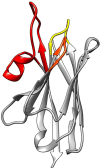The Therapeutic Potential of Nanobodies
- PMID: 31686399
- PMCID: PMC6985073
- DOI: 10.1007/s40259-019-00392-z
The Therapeutic Potential of Nanobodies
Abstract
Today, bio-medical efforts are entering the subcellular level, which is witnessed with the fast-developing fields of nanomedicine, nanodiagnostics and nanotherapy in conjunction with the implementation of nanoparticles for disease prevention, diagnosis, therapy and follow-up. Nanoparticles or nanocontainers offer advantages including high sensitivity, lower toxicity and improved safety-characteristics that are especially valued in the oncology field. Cancer cells develop and proliferate in complex microenvironments leading to heterogeneous diseases, often with a fatal outcome for the patient. Although antibody-based therapy is widely used in the clinical care of patients with solid tumours, its efficiency definitely needs improvement. Limitations of antibodies result mainly from their big size and poor penetration in solid tissues. Nanobodies are a novel and unique class of antigen-binding fragments, derived from naturally occurring heavy-chain-only antibodies present in the serum of camelids. Their superior properties such as small size, high stability, strong antigen-binding affinity, water solubility and natural origin make them suitable for development into next-generation biodrugs. Less than 30 years after the discovery of functional heavy-chain-only antibodies, the nanobody derivatives are already extensively used by the biotechnology research community. Moreover, a number of nanobodies are under clinical investigation for a wide spectrum of human diseases including inflammation, breast cancer, brain tumours, lung diseases and infectious diseases. Recently, caplacizumab, a bivalent nanobody, received approval from the European Medicines Agency (EMA) and the US Food and Drug Administration (FDA) for treatment of patients with thrombotic thrombocytopenic purpura.
Conflict of interest statement
Ivana Jovčevska and Serge Muyldermans declare they have no conflict of interest.
Figures


References
Publication types
MeSH terms
Substances
Grants and funding
LinkOut - more resources
Full Text Sources
Other Literature Sources
Research Materials

